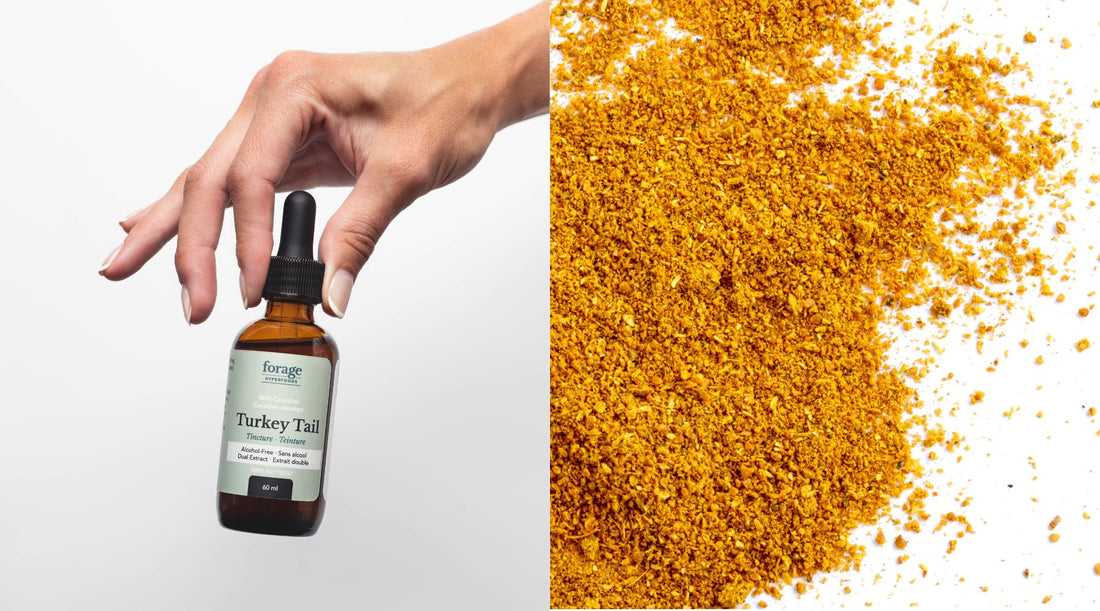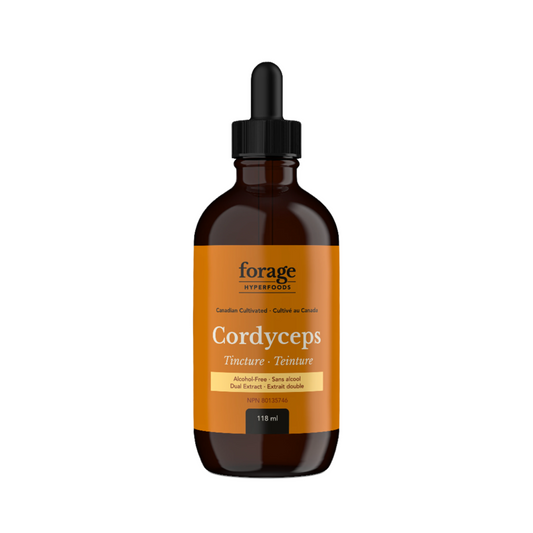
Mushroom Tinctures vs. Powders
Share
When it comes to incorporating the benefits of medicinal mushrooms into your daily routine, you might find yourself choosing between tinctures and powders. Both forms have their unique advantages and drawbacks. In this blog, we'll explore the differences between mushroom tinctures and powders, and help you decide which might be the better option for you.
Benefits of Mushroom Tinctures
1. Higher Potency and Bioavailability
Tinctures are highly concentrated, which means you can achieve the desired effects with a smaller amount compared to powders. The liquid form allows for faster and more efficient absorption of the active compounds into the bloodstream. When taken sublingually (under the tongue), tinctures bypass the digestive system, ensuring that the beneficial compounds are quickly absorbed.
2. Quality and Purity
With tinctures, you can be more confident about the quality and purity of the product. Forage Hyperfoods uses an ultrasonic-assisted dual extraction process. This innovative process ensures that our tinctures capture the full spectrum of beneficial compounds. We only use three ingredients in our tinctures- whole-fruiting body mushrooms, solvent and water. Powders, while also effective if mushroom material is present and extracted, often contain fillers or additives that dilute the potency and purity of the product.
3. Customizable Dosage
Tinctures offer the flexibility to easily adjust your dosage according to your needs. You can take a few drops or a full dropper, depending on the concentration and your personal requirements. Powders also allow for dosage adjustments, but measuring out precise amounts can be more cumbersome.
4. Convenient and Portable
Tinctures are easy to carry and can be taken without the need for any preparation. You can take them directly under the tongue, add them to beverages, or mix them into recipes. This makes them ideal for people on the go.
Drawbacks of Mushroom Tinctures
1. Strong Taste
One of the most common drawbacks of tinctures is their strong taste. Alcohol-based tinctures, in particular, can have a very strong earthy flavour that some people find unpleasant. While Alcohol-Free tinctures made with vegetable glycerin often have a sweeter taste, they can still be too intense for some.
2. Alcohol Content
For those who avoid alcohol for personal, health, or religious reasons, alcohol-based tinctures may not be an option. This is why we offer Alcohol-Free tinctures.
Benefits of Mushroom Powders
1. Versatility in Usage
Mushroom powders can be easily incorporated into a wide variety of foods and beverages. You can add them to smoothies, soups, sauces, or baked goods without significantly altering the taste or texture. This makes them a highly versatile option for daily use. However, powders containing grains and fillers can be challenging to mix into beverages, leading to clumping and uneven distribution.
2. Mild Taste
Powders generally have a milder taste compared to tinctures, which makes them more palatable for many people. They generally blend well into different recipes, allowing you to enjoy the benefits of mushrooms without the strong flavour that tinctures can have.
3. Cost-Effective
Mushroom powder supplements are generally lower in cost compared to tinctures for several reasons. One significant difference is that tinctures undergo a thorough extraction process that removes indigestible mushroom material, resulting in a highly concentrated liquid filled with bioactive compounds. In contrast, powders often retain this indigestible material to add weight to the overall product, which can contribute to lower manufacturing costs. Additionally, powders can be made from a wider variety of raw materials, including mycelium and grains, which are often less expensive than the mature, whole fruiting bodies used to produce tinctures.
Drawbacks of Mushroom Powders
1. Reduced Potency and Bioavailability
Powders must be digested and processed by the body before the active compounds can be absorbed. However, our bodies cannot effectively break down the tough cellular structures of functional mushrooms, which is why extraction is crucial for maximizing their health benefits.
Steaming functional mushrooms can be an effective method for extracting some of their active compounds, particularly polysaccharides and other water-soluble components. However, while steaming does enhance the extraction of certain compounds, it may not be as thorough or effective as other extraction methods, such as dual extraction or ultrasonic extraction. These methods use solvents like water and alcohol to extract a wider range of bioactive compounds, including those that are less soluble in water, such as terpenes and triterpenoids.
Additionally, many mushroom powders contain material that is not thoroughly extracted, leaving behind indigestible components that further diminish their efficacy. As a result, the therapeutic potential of the mushroom may be lost, leading to a less effective supplement experience.
2. Inconsistent Quality and Composition
Many mushroom powders on the market do not contain actual mushrooms or lack thorough extraction processes, as mentioned above. This can result in products that are less effective and do not deliver the promised health benefits. Additionally, some powders may contain mycelium, which has lower potency than mature and whole fruiting body mushrooms, further diminishing their efficacy.
3. Hidden Fillers and Additives
Some mushroom powders may contain fillers, binders, or other additives that are not clearly disclosed on the label or are listed under misleading or vague names, making it difficult for consumers to know exactly what they are ingesting. These substances are often included to improve texture, extend shelf life, or enhance the manufacturing process, but they can dilute the potency of the mushroom extract, ultimately reducing its effectiveness.
Common Fillers and Additives in Mushroom Powder Supplements
-
Mycelial Biomass
The root structure of the mushroom, which is often included in powders but generally has lower potency compared to the fruiting body. -
Cultured Oats / Organic Myceliated Oats
Often used as a cost-effective substrate for growing mycelium; while they may provide some nutritional benefits, they can dilute the mushroom content as the mycelium cannot be separated from the oats. -
Freeze-Dried Myceliated Brown Rice
As with oats, this brown rice is sometimes used as a growing medium for mushrooms and can be included in supplements, potentially reducing the overall potency of active compounds. -
Rice Powder
Used to add bulk or improve texture, but can diminish the concentration of beneficial mushroom extracts. -
Rice Hull Concentrate
A byproduct of rice processing that may be added to improve flowability but lacks significant nutritional value. -
Flavourings and Sweeteners
Artificial or natural flavourings and sweeteners may be added to enhance taste, potentially introducing unwanted ingredients or additives.
Conclusion: Why Tinctures Are the Better Choice
While both mushroom tinctures and powders have their place, tinctures offer several distinct advantages that make them the better option for many people. Their higher potency, better bioavailability, customizable dosage, and purity make them a superior choice for those looking to maximize the health benefits of medicinal mushrooms.
At Forage Hyperfoods, we are committed to providing high-quality mushroom tinctures made with the purest ingredients and advanced extraction methods. Whether you're looking to boost your immune system, enhance cognitive function, or support overall wellness, our tinctures offer a powerful and convenient way to incorporate the benefits of medicinal mushrooms into your daily routine.
Choose tinctures for a purer, more effective, and versatile mushroom supplement. Experience the difference with Forage Hyperfoods' premium mushroom tinctures and elevate your health journey today.



